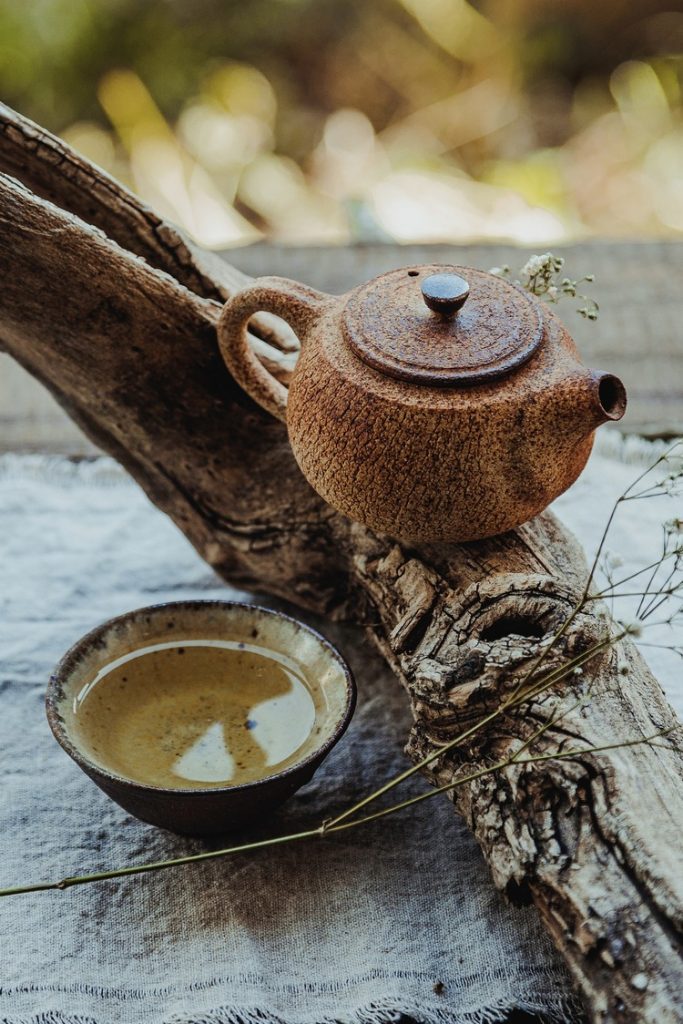Kukicha is a type of green tea that has gained popularity recently. Kukicha tea, also known as twig tea, is made from the stems and twigs of the tea plant, rather than the leaves. This gives it a distinct flavor and aroma that sets it apart from other types of green tea.
Kukicha is a traditional Japanese tea that has been enjoyed for centuries. It is made from the same plant as other green teas, but the stems and twigs are separated from the leaves during processing. The result is a tea lower in caffeine and tannins than other green teas, making it a great choice for those sensitive to these compounds.
Kukicha has a mild, slightly sweet flavor with a nutty undertone often described as having a creamy or buttery texture.
If you want to keep learning about this tea, keep reading!
Please note: This article contains affiliate links, meaning I may earn a commission if you make a purchase by clicking a link. Of course, this comes at no extra cost to you and helps me keep offering readers solid information.

What is Kukicha?
If you’re a fan of green tea, you may have heard of Kukicha. And hopefully, you have tried it as well!
Kukicha is a type of green tea that originates from Japan. It is also known as “twig tea” or “bōcha” in Japanese. Kukicha is unique because it is made from the twigs, stems, and stalks of the Camellia sinensis plant, which is used to produce green tea, black tea, and other varieties.
The production of kukicha involves gathering the twigs and stems of the tea plant after the leaves have been harvested. These twigs are then dried and/or roasted, resulting in a mild and slightly nutty flavor. The tea has a light yellow or pale green color with a refreshing and delicate taste.
Kukicha is often enjoyed in Japan as a traditional tea and is known for its low caffeine content compared to other tea types. It is appreciated for its smooth and soothing qualities, making it a popular choice for those seeking a tea with a milder taste and lower caffeine intake.
Varieties of Kukicha
Kukicha comes in several varieties that offer different flavors and characteristics. The specific type of tea plant parts used, and processing methods employed determine these varieties. Here are some of the common varieties:
Karigane
Karigane is a type of Kukicha made from the stems and leaves of Gyokuro, a high-quality Japanese green tea. Gyokuro is grown in the shade for several weeks before harvesting, which gives it a rich, sweet flavor and a deep green color. Karigane is made from the stems and leaves left over after picking the Gyokuro leaves.
Karigane has a light, refreshing taste with a slightly sweet aftertaste. It’s an excellent choice for those who prefer a milder green tea.
Konacha Kukicha
Konacha kukicha is produced using the leftover tea particles from the processing of Sencha or Gyokuro. It consists of small tea leaves, stems, and twigs. Konacha kukicha has a robust flavor with a slightly grassy or vegetal taste. It is often used in Japanese tea ceremonies and popular for everyday drinking.
Hojicha Kukicha
Hojicha kukicha is made from roasted kukicha twigs and stems. The roasting process gives it a distinct nutty and toasty flavor and a reddish-brown color. Hojicha kukicha has a mellow and comforting taste, making it a popular choice for those seeking a low-caffeine alternative.
Genmaicha Kukicha
Genmaicha kukicha is a blend of kukicha and roasted brown rice. The combination results in a unique and satisfying flavor profile. The roasted rice provides a nutty and popcorn-like taste, complementing kukicha’s mild and smooth character. Genmaicha kukicha is often enjoyed as a comforting and earthy tea.
Barley Kukicha
Barley kukicha, or mugicha kukicha, is a blend of kukicha twigs and roasted barley grains. It has a rich, nutty flavor with a hint of sweetness. Barley kukicha is often consumed as a refreshing and cooling tea, particularly in summer.

What Does Kukicha Taste Like?
Kukicha tea has a light, nutty, refreshing, and soothing flavor. The aroma is subtle and earthy, with a hint of sweetness.
The flavor of Kukicha tea is derived from the combination of stems, twigs, and leaves used to make it. The stems and twigs taste slightly woody, while the leaves add a hint of sweetness. This combination creates a well-rounded flavor that is both soothing and satisfying.
The aroma of Kukicha tea is light and subtle, with a hint of earthiness. The tea has a delicate fragrance that is both calming and refreshing. It is a perfect tea to enjoy when you need a moment of relaxation.
How To Brew Kukicha Tea
Brewing kukicha tea is a simple and enjoyable process. Here’s a step-by-step guide on how to brew the tea:
- Start with quality kukicha tea: Ensure you have high-quality kukicha tea, preferably loose leaf, for the best flavor and aroma. Kukicha tea can be found at specialty tea stores or online.
- Gather your brewing equipment: You will need a teapot or teacup with a strainer or infuser, a kettle or pot for boiling water, and a timer (optional).
- Boil water: Fill your kettle or pot with fresh, filtered water and bring it to a boil. The ideal temperature for brewing kukicha is around 175°F (80°C). If you don’t have a thermometer, you can boil the water and let it cool for a couple of minutes before using it.
- Measure the tea: For a standard cup of kukicha tea, use approximately 1 to 2 teaspoons of loose-leaf kukicha. Adjust the amount according to your taste preferences and the size of your teapot or cup.
- Preheat your teapot or cup: Pour a small amount of hot water into your teapot or cup to preheat it. Swirl the hot water around and then discard it.
- Add the kukicha tea: Place the measured kukicha tea leaves into the teapot or infuser.
- Pour the water: Slowly pour the hot water over the kukicha tea leaves. The water should cover the leaves completely. Avoid using boiling water, as it may scorch the delicate flavors of kukicha. Let the tea steep for about 2 to 3 minutes.
- Steep the tea: Allow the kukicha tea to steep for the desired duration. The steeping time can be adjusted based on your preference for a lighter or more potent flavor. You may experiment with different steeping times to find your preferred taste profile.
- Strain and serve: Once the steeping time is complete, remove the tea leaves by straining the tea into your teacup or serving pot. If using a teapot with an infuser, remove the infuser. If you brewed the tea directly in a teacup, you can use a small handheld strainer to strain out the leaves.
- Enjoy your kukicha tea: Savor the flavors and aromas of your freshly brewed kukicha tea. You can drink it as is or add desired sweeteners like honey or sugar. Kukicha is often enjoyed without milk, but you can experiment with adding a splash of milk or alternative milk options if you prefer.

Food Pairings
Kukicha pairs well with various foods, complementing different flavors and textures. Here are some food pairings that go well with this tea:
- Japanese Cuisine: Given its Japanese origins, kukicha naturally pairs well with traditional Japanese dishes. It complements the flavors of sushi, sashimi, and other seafood delicacies.
- Light Vegetables: Kukicha’s mild and delicate taste makes it an excellent accompaniment to light and fresh vegetable dishes. It pairs well with steamed or stir-fried vegetables, salads, and vegetable sushi rolls. The tea’s subtle flavors won’t overpower the natural taste of the vegetables, allowing their freshness to shine through.
- Grilled or Roasted Chicken: The nutty and slightly toasty flavor of kukicha harmonizes with grilled or roasted chicken. The tea’s gentle flavors provide a complementary backdrop to the savory and juicy qualities of the chicken.
- Nuts and Seeds: Kukicha’s mild and nutty undertones make it a great pairing with various nuts and seeds. Almonds, walnuts, sesame, and pumpkin seeds complement the tea’s flavor profile and add an enjoyable textural contrast. Enjoy a handful of mixed nuts, or add toasted seeds to your kukicha tea time.
- Light Pastries and Desserts: Kukicha can be a lovely accompaniment to light pastries and desserts. Its gentle flavor won’t overpower delicate treats such as shortbread cookies, fruit tarts, or soft sponge cakes. The tea’s mild sweetness and nutty notes can enhance the experience of enjoying these desserts.
- Rice-based Dishes: Kukicha pairs well with rice-based dishes such as bowls, pilaf, or salads. The tea’s subtle flavor complements the neutral taste of rice while providing a refreshing and cleansing effect to the palate.

Health Benefits of Kukicha Tea
Kukicha is an excellent choice if you’re looking for a healthy and delicious tea to add to your diet. Here are some health benefits you can expect from drinking this tea.
Antioxidants and Vitamins
Kukicha is rich in antioxidants, which can help protect your body from damage caused by free radicals. It also contains vitamins A, C, and E, essential for maintaining healthy skin, eyes, and immune function.
Minerals and Tannins
Kukicha is also a good source of minerals like calcium, magnesium, and potassium, which are essential for strong bones and healthy muscles. It also contains tannins, which can help improve digestion and reduce inflammation.
Digestion and Energy
Kukicha is a great tea to drink after a meal, as it can help aid digestion and reduce bloating. It can also provide a gentle energy boost without the jitters or crashes associated with high-caffeine drinks like coffee.
Low Caffeine Levels and High Calcium Content
One of the unique things about Kukicha is its low caffeine content. This makes it a great choice for people sensitive to caffeine or wanting to avoid it altogether. Additionally, Kukicha has a high calcium content, which can help support strong bones and teeth.
Buying Recommendations
We always recommend visiting your nearest tea specialist to obtain high-quality products and deepen your tea knowledge. Besides, you may be able to try several tea brands before making a purchase decision.
Since we know not everybody has the time to stop by a local tea provider, here are our top loose-leaf recommendations (from online retailers since we are advocates of enjoying the complete flavor profile of tea):
Ocha & Co. Organic Green Tea – Kukicha Green Tea from Stems & Leaf

Davidson’s Tea Bulk, Organic Kukicha

Numi Organic Kukicha Green Tea, Roasted Japanese Twig Tea

Haiku Japanese Kukicha Organic Twig Tea

I hope you have enjoyed the article and learned something new!
Have you tried kukicha tea?
More About Green Tea
What Does Green Tea Taste Like?
What Does Sencha Tea Taste Like?